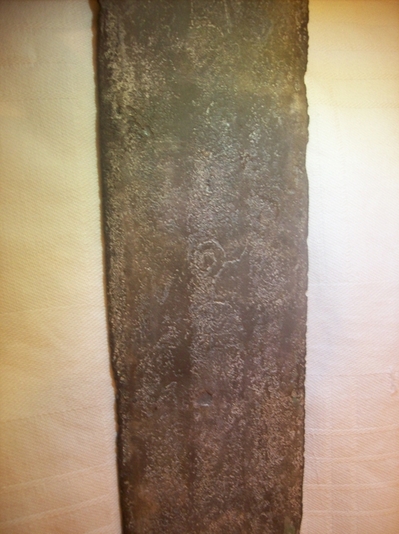Posts: 3
Tue 01 Feb, 2011 11:24 am
A sword with unknown origin
Posts: 247
Tue 01 Feb, 2011 12:41 pm
Can you provide a close up view of the handle?
Posts: 605
Thu 03 Feb, 2011 6:18 pm
Intriguing. I especially would like a closer view of the hilt. Is the pommel broken off?
Posts: 87 Location: Holland
Fri 04 Feb, 2011 3:22 am
Hi,
I think it started as a 14thC/15THC sword with a pommel! (The crozier mark has been frequently used in the 14Th and 15thC on medieval sword blades and stands for loyalty to ruler and church)
during its working life probably In the 16thC century it must have been changed in the matter of a hunting sword or great knife. the blade is shortened in order to fabricate the wide tang and grip plates are riveted on. riveted grips are hardly seen before 1500.
cross can or cannot be the original one. still a very interesting piece not sure about its balance w/o a counterweight/ pommel.
best,
Posts: 1,085 Location: Finland
Sat 05 Feb, 2011 3:19 am
Whatever it is, it's certainly not a viking era sword. My amateur guess would be a 16th Century German hunting sword, possibly fashioned from an older blade (like Cornelis just said).
Close-ups of the hilt would be very helpful - and I think I can just make out another sign above the crosier in the second photo, just below the guard; a closer look at that would also be interesting.
PS. Oh, and if you have measurements besides weight, especially blade and grip lengths, that'd help, too. I can make a very rough guess based on the proportions, of course, but I'd rather not. :)
Posts: 238 Location: Lyons, France
Sat 05 Feb, 2011 12:17 pm
Hi again Miodrag,
I already replied to this over on SFI. Perhaps it's my post you refer to regarding it being a Viking sword. In fact, I had suggested that the combination of a wide blade and a very short guard made me think of an Early medieval sword, but indeed it is clearly not Viking or Early medieval, as I had stated at the time.
Allow me to repeat a question I asked over here, too: is there only one fuller (groove) running down the blade? I'm unsure from the photos and it could help dating the blade.
Cornelis & Mikko, very good theory. I can see now how this could've been a rather beautiful greatsword blade in the beginning. What piques my curiosity is still this tiny, tiny guard, strikes me as odd for the 16th c. hunting sword or no... Not disputing your theory, however, it seems to make a great deal of sense. And I suppose it could be the work of a rather unskilled cutler/blacksmith, as guard and grip don't seem to be of very good quality... In which case it is a shame he cut this blade (okay, I'm partial to big wide greatswords, guilty as charged).
Regards,
Simon
You
cannot post new topics in this forum
You
cannot reply to topics in this forum
You
cannot edit your posts in this forum
You
cannot delete your posts in this forum
You
cannot vote in polls in this forum
You
cannot attach files in this forum
You
can download files in this forum





